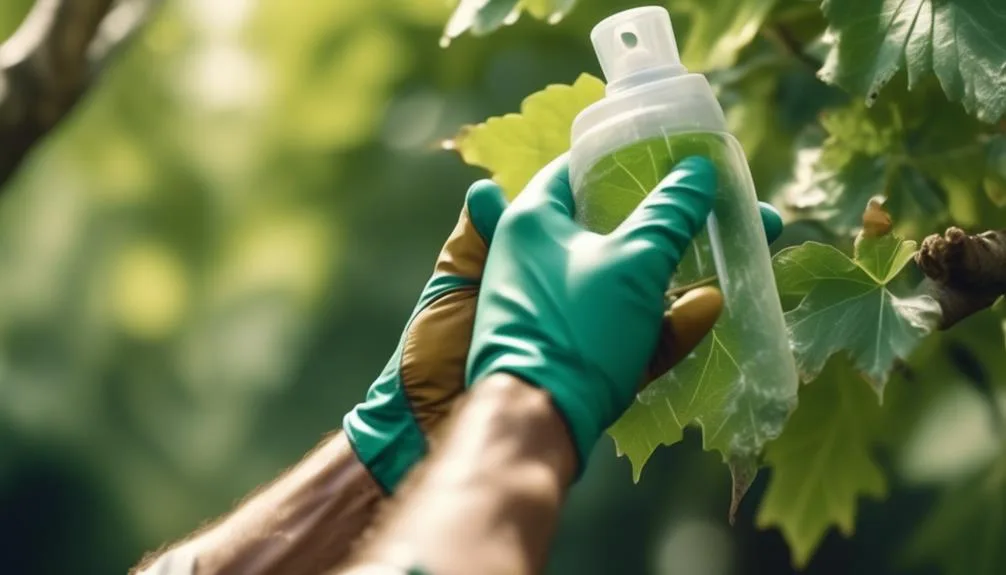Discover effective ways to control pests on sycamore trees.
Learn about common pests and how to combat them using natural remedies and pest management strategies.
Protect your trees and keep them healthy.
Identifying Sycamore Tree Pests
To identify pests on your sycamore trees, start by closely examining the leaves, branches, and trunk for any signs of damage or unusual activity. Pest identification techniques involve looking for visible pests such as caterpillars, beetles, or aphids.
Early pest detection techniques include checking for chewed or discolored leaves, wilting branches, or small holes in the trunk. Look for sticky substances on the leaves, which could indicate the presence of pests like scale insects or aphids. Also, inspect the underside of the leaves for the presence of eggs or larvae.
Natural Pest Control Methods
Inspecting your sycamore trees for pests not only helps in identifying the issues, but it also lays the foundation for implementing natural pest control methods to safeguard the health of your trees.
When it comes to natural pest control methods for sycamore trees, consider the following options:
- Organic solutions: Utilize natural insecticidal soaps or neem oil to combat pests without harming beneficial insects.
- Biological controls: Introduce natural predators like ladybugs or lacewings to help control pest populations.
- Beneficial nematodes: These microscopic organisms can be used to target soil-dwelling pests without harming the tree.
- Companion planting: Cultivate plants like chrysanthemums or marigolds around your sycamore trees to repel pests and attract beneficial insects.
Chemical Pest Control Options
When considering chemical pest control options for your sycamore trees, it's important to prioritize the safety of the tree and surrounding environment while effectively managing pest infestations. Before applying any chemical pesticides, always read and follow the label instructions carefully. Use recommended protective gear such as gloves, masks, and eye protection as safety precautions.
It's crucial to choose pesticides specifically labeled for sycamore trees and the targeted pests to minimize environmental impact. Consider using selective insecticides that target specific pests while preserving beneficial insects. Additionally, timing the application of chemical pesticides when pollinators are less active can reduce the impact on beneficial insects.
Always store and dispose of chemical pesticides according to local regulations to minimize environmental harm. Remember, chemical pest control should be a last resort after exhausting non-chemical methods.
Integrated Pest Management (IPM) Strategies
Considering the importance of prioritizing the safety of your sycamore trees and the surrounding environment while effectively managing pest infestations, it's valuable to explore Integrated Pest Management (IPM) Strategies as a holistic approach to pest control.
- Biological Control: Introduce natural predators like ladybugs or parasitic wasps to control pest populations.
- Cultural Control: Optimize tree health through proper irrigation, pruning, and mulching to prevent pest infestations.
- Mechanical Control: Use physical barriers or traps to deter pests from infesting sycamore trees.
- Chemical Control: Utilize pesticides sparingly and selectively, considering their environmental impact and economic benefits.
Implementing IPM strategies not only minimizes the environmental impact but also offers long-term economic benefits by reducing the need for chemical interventions and promoting a balanced ecosystem around your sycamore trees.
Preventing Future Pest Infestations
To prevent future pest infestations on your sycamore trees, establish a regular maintenance schedule to monitor tree health and promptly address any signs of pest activity.
Tree pruning plays a crucial role in preventing pest infestations by removing dead or diseased branches where pests can thrive. Regular pruning also promotes better air circulation and sunlight exposure, which can strengthen the tree's natural defenses against pests.
Additionally, maintaining good soil health is essential. Ensure that the soil around your sycamore trees is well-draining and adequately fertilized to support the tree's overall health and resilience. Healthy trees are better equipped to resist pest infestations.
Conclusion
Incorporating natural and integrated pest management methods will help maintain the health of your sycamore trees while keeping pests at bay.
Regular monitoring and preventive measures are crucial for long-term tree care.
By staying vigilant, your sycamore trees can thrive for years to come.
Happy tree-tending!

My interest in trees started when I first saw the giant sequoias in Yosemite.
I was a teenager then, and I remember thinking, “I need to learn more about this.”
That moment stuck with me.
A few years later, I went on to study forestry at Michigan Tech.
Since graduating, I’ve worked in a mix of hands-on tree care and community education.
I’ve spent over ten years helping people understand how to plant, maintain, and protect the trees in their neighborhoods.
I don’t see trees as just part of the landscape.
They are living things that make a real difference in our daily lives.
